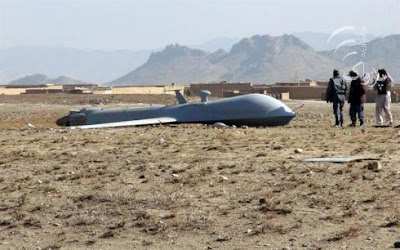Russia gave Israel codes for breaking Iran’s missile defense system in return for codes of Unmanned Aerial Vehicles (UAVs) Israel sold to Georgia, WikiLeaks claims.
The information was among 5 million emails released this week by WikiLeaks, which said it worked in cooperation with the Anonymous hacker group. The leaked information focused on the U.S.-based Stratfor global intelligence company.
A source identified as “A” was quoted in an e-mail from a Stratfor employee as having heard from a “former Mexican cop” and military analysts that "the Georgians are frantically looking for a replacement for the Israeli UAVs that were compromised.”
The Israeli-based Elbit company had sold UAVs to Georgia since 2007, and earlier this month Georgia said it is replacing the Hermes UAVs.
“Met with my Mexican source/friend again today and dude is getting shadier by the day. We followed up on our past discussion on Russia compromising the Israeli-made Georgian UAVs prior to the August war,” said one e-mail.
“I inquired more about the compromised Israeli UAVs,” it continued. “What he explained was that Israel and Russia made a swap -- Israel gave Russia the 'data link' code for those specific UAVs; in return, Russia gave Israel the codes for Iran's Tor-M1s [missile defense system].
“I asked about the S-300 (source tracks a lot of defense deals for Jane's). He doesn't think the Russians will give it to the Iranians. Besides, he said... Israel and Turkey have been collaborating very closely on the S-300s….The gist of what he said is that Turkey has been cracking the S-300 since the Crete sale and has been sharing intel on the S-300 with the Israelis to ensure that they retain an advantage over Iran should Iran get them from the Russians.
“SOURCE DESCRIPTION: MX301 - Former Mexican cop, Latam military analyst, writes for Jane's; SOURCE RELIABILITY: A
“The Russians got the data link for the UAV (there is some suspicion that the Israelis after the war may have given this to them…. So, since the Georgian UAVs were compromised, they then tried to sell them to the Azerbaijanis. I don’t know if that deal went through.”
The information was among 5 million emails released this week by WikiLeaks, which said it worked in cooperation with the Anonymous hacker group. The leaked information focused on the U.S.-based Stratfor global intelligence company.
A source identified as “A” was quoted in an e-mail from a Stratfor employee as having heard from a “former Mexican cop” and military analysts that "the Georgians are frantically looking for a replacement for the Israeli UAVs that were compromised.”
The Israeli-based Elbit company had sold UAVs to Georgia since 2007, and earlier this month Georgia said it is replacing the Hermes UAVs.
“Met with my Mexican source/friend again today and dude is getting shadier by the day. We followed up on our past discussion on Russia compromising the Israeli-made Georgian UAVs prior to the August war,” said one e-mail.
“I inquired more about the compromised Israeli UAVs,” it continued. “What he explained was that Israel and Russia made a swap -- Israel gave Russia the 'data link' code for those specific UAVs; in return, Russia gave Israel the codes for Iran's Tor-M1s [missile defense system].
“I asked about the S-300 (source tracks a lot of defense deals for Jane's). He doesn't think the Russians will give it to the Iranians. Besides, he said... Israel and Turkey have been collaborating very closely on the S-300s….The gist of what he said is that Turkey has been cracking the S-300 since the Crete sale and has been sharing intel on the S-300 with the Israelis to ensure that they retain an advantage over Iran should Iran get them from the Russians.
“SOURCE DESCRIPTION: MX301 - Former Mexican cop, Latam military analyst, writes for Jane's; SOURCE RELIABILITY: A
“The Russians got the data link for the UAV (there is some suspicion that the Israelis after the war may have given this to them…. So, since the Georgian UAVs were compromised, they then tried to sell them to the Azerbaijanis. I don’t know if that deal went through.”




























